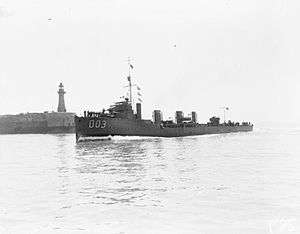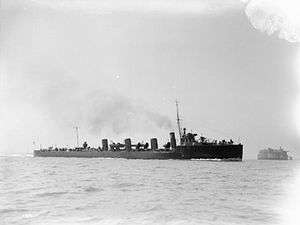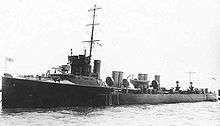Tribal-class destroyer (1905)
 | |
| Class overview | |
|---|---|
| Name: | Tribal (or F) |
| Operators: |
|
| Preceded by: | River class |
| Succeeded by: | Beagle (or G) class |
| Built: | 1905–1908 |
| In commission: | 1907–1920 |
| Completed: | 12 |
| General characteristics | |
| Type: | Destroyer |
| Displacement: | 860 - 940 tons |
| Length: | 275 ft (84 m) |
| Beam: | 28 ft (8.5 m) |
| Draught: | 8 ft 6 in (2.59 m) |
| Propulsion: |
|
| Speed: | 33 knots (61 km/h; 38 mph) |
| Armament: |
|
The Tribal or F class was a class of destroyers built for the Royal Navy. Twelve ships were built between 1905 and 1908 and all saw service during World War I, where they saw action in the North Sea and English Channel as part of the 6th Flotilla and Dover Patrols.
Design
The preceding River- or E-class destroyers of 1903 had made 25.5 knots (47.2 km/h; 29.3 mph) on the 7,000 ihp (5,200 kW) provided by triple expansion steam engines and coal-fired boilers, although HMS Eden was powered by steam turbines.[1] In November 1904, the First Sea Lord "Jackie" Fisher proposed that the next class of destroyers should make at least 33 knots (61 km/h) and should use oil-fired boilers and steam turbines as a means of achieving this.[2] This resulted in a larger ship to provide the required doubling of installed power over their predecessors, but also pushed the design to the limits of capability of contemporary technology. As a result, the Tribals were severely compromised and a somewhat retrograde step after the excellent River class; they were lightly built and proved to be fragile in service. More alarmingly however, they were only provided with 90 tons of bunkerage, and with high fuel consumption resulting from the unheard of power of 12,500 shp (9,300 kW), they were very uneconomical and had a severely limited radius of action; Afridi and Amazon once used 9.5 tons of oil each simply to raise steam for a three-mile (5 km) return journey to a fuel depot.
Design details were left to the individual builders, as was Royal Navy practice at the time for destroyers. As a result, no two were alike[3][4] and there was considerable heterogeneity of detail and appearance, Most noticeably the number of funnels varied from three, in Cossack and Ghurka, to six in Viking; the latter, with two single and two pairs of funnels becoming the only six-funneled destroyer ever built. With a light mainmast aft, they were the first British destroyers to have two masts.
The first five ships were designed with the armament of three QF 12-pounder guns, an improvement from the single 12-pounder and five 6-pounder guns that the River class was completed with, while the number of torpedoes remained at two 18-inch (457 mm) tubes.[5][6] From the sixth ship (Saracen) onwards, however, the armament was again increased, to a pair of BL 4-inch (102 mm) guns, with one gun mounted forward and another on the quarterdeck.[7] From October 1908, the first five ships were modified by adding another pair of 12 pounder guns.[8]
The shift towards the larger Tribals also created a requirement for a complementary class of smaller “Coastal” destroyers giving rise to the Cricket class of small TBD, of which 36 were built between 1905 and 1908. The result of this experiment was not ideal and for the following class of destroyers (the 'G', or Beagle, class) the Admiralty reverted to a single, more uniform design for the 1908-9 programme.
Ships
Five vessels were ordered and built under the 1905-06 Programme.
| Name | Builder | Launch date | Fate | Image |
|---|---|---|---|---|
| Afridi | Vickers Armstrong, Newcastle upon Tyne | 8 May 1907 | sold for breaking up 1919 |  |
| Cossack | Cammell Laird, Birkenhead | 16 February 1907 | sold for breaking up 1919 | _IWM_Q_021123.jpg) |
| Ghurka | Hawthorn, Newcastle upon Tyne | 29 April 1907 | mined and sunk off Dungeness Buoy 8 February 1917 |  |
| Mohawk | J S White, Cowes | 15 March 1907 | Sold for breaking up 1919 | |
| Tartar | J I Thornycroft, Woolston | 25 June 1907 | sold for breaking up 1921 |
Five more vessels were proposed, but only two were ordered and built under the 1906-07 Programme.
| Name | Builder | Launch date | Fate | Image |
|---|---|---|---|---|
| Amazon | J I Thornycroft, Woolston | 29 July 1908 | sold for breaking up 1919 |  |
| Saracen | J S White, Cowes | 31 March 1908 | sold for breaking up 1919 |
A final five vessels were ordered and built under the 1907-08 Programme.
| Name | Builder | Launch date | Fate | Image |
|---|---|---|---|---|
| Crusader | J S White, Cowes | 20 March 1909 | sold for breaking up 1920 |  |
| Maori | William Denny & Brothers, Dumbarton | 24 May 1909 | mined and sunk off Wirlingen Light Ship, Zeebrugge, 7 May 1915 | |
| Nubian | J I Thornycroft, Woolston | 21 April 1909 | torpedoed and damaged by German destroyers in action off Folkestone, 27 October 1916 | |
| Viking | Palmers, Jarrow | 14 September 1909 | sold for breaking up 1919 |  |
| Zulu | Hawthorn, Newcastle upon Tyne | 16 September 1909 | mined and damaged 27 October 1916 |  |
Following the damage to Nubian and Zulu in October 1916, it was proposed on 8 November 1916 that the two undamaged 'ends' might be joined together, which was completed at Chatham Royal Dockyard 7 June 1917 by joining the undamaged fore section of Zulu and the rear section of Nubian respectively. The resulting destroyer was commissioned on 7 June 1917 as Zubian, which was sold for scrapping 1919.
Notes
References
- Chesneau, Roger and Kolesnik, Eugene M. Conway's All The World's Fighting Ships 1860–1905. London: Conway Maritime Press, 1979. ISBN 0-85177-133-5.
- Cocker, Maurice. Destroyers of the Royal Navy, 1893-1981. Ian Allan, 1983. ISBN 0-7110-1075-7
- Friedman, Norman. British Destroyers: From Earliest Days to the Second World War. Barnsley, UK: Seaforth Publishing, 2009. ISBN 978-1-84832-049-9.
- Gardiner, Robert and Gray, Randal. Conway's All The World's Fighting Ships 1906–1921. London: Conway Maritime Press, 1985. ISBN 0-85177-245-5.
- Preston, Anthony. Destroyers. Bison Books, 1977. ISBN 0-86124-057-X
External links
| Wikimedia Commons has media related to Tribal class destroyer (1905). |